It seems like nowadays, everyone is in a hurry, and wants a fast truck to get them where they want to go, and with a diesel under the hood, you can do that and more. With modern advances in turbocharging, tuning, and fuel system parts, it’s possible to take a stock 350hp truck and transform it into a 1,000hp fire breathing monster which can rip up and down the track at a blazing rate of speed. If you own a truck which is a pre-2008, you have things pretty easy, since you can modify the truck however you like with giant turbos and 5” exhaust without violating any laws: that’s because older trucks simply had very few or no emission control devices. However, if you are among the increasing number of people who drive a 2008 or newer diesel, your truck will be equipped with a DPF and/or DOC in the exhaust system (among other things) which traps soot and harmful compounds, and uses heat and chemical reactions to break down the pollutants into something much less harmful: water and CO2. For a while, it was popular to remove those emissions components from the truck, add a few other performance parts, and make a little more horsepower than stock. The major drawback is that would render the vehicle unable to be legally driven on public roadways, and on top of that, it’s not even necessary to delete the truck if all you’re really after is to make a small gain in performance.
While a particulate filter can support more power than the stock engines are rated for, you’re likely never going to make 1,000hp emission equipped. The DPF and DOC are unable to physically flow the volume of air required to make that much power, plus a diesel operating at that level would produce so much soot the exhaust filter would be constantly plugging up and going into re-gen mode. On top of all that, it’s not really practical to build a high power daily-driven diesel anyhow, since you need to replace so much of the stock drivetrain, you might as well have a dedicated race truck which never sees the public roads anyway.
As of late, we’ve been discussing ways to add horsepower in the traditional manner; big turbos, big injectors, and maximum effort tuning. However, not everyone needs another 400-500 horsepower over stock, and many drivers simply want a more powerful and efficient truck they can use to work, haul, and commute with, and ¼ mile times or dyno numbers aren’t even on their radar. The good news is, lately there’s been a change in the market, and tuners as well as builders are embracing the “clean power” trend, and now we’re realizing there is a way to have your cake and eat it too. It’s actually impressive how much power you can extract from a modern truck while keeping the DPF and all other emissions control systems intact, and if done properly, you’ll actually burn less fuel and create less pollution in the first place, which means there is less work for the DPF to do, and it will use less exhaust fluid as well.
So, Where Do I Sign Up?
Since most of this discussion is geared toward later model trucks with lower miles, there is one assumption we need to make, and that is you might want to keep your powertrain warranty intact. While technically any modification to your truck could have an impact on its warranty, most dealers are friendly to mild modifications if they don’t have a huge impact or directly cause a failure of another component. So, at first, we’ll discuss the upgrades that can be done to improve performance without leaving a very big footprint. And just like with any truck, it starts with an intake, exhaust, and a tune.
Any truck you buy new from the dealer’s lot today has more computing power than a space shuttle from the 1970’s. There are control modules everywhere, LTE and WIFI connections communicating back and forth, and you can even have your truck send you an email when it needs an oil change. One little roadblock to adding performance without affecting your warranty is in the engine’s computer, and the fact that it keeps track of each time a reflash is performed. Even if you return a programmer to stock and remove it from the truck, the dealership will still be able to tell as soon as they plug in their scan tool, so there’s no pulling the wool over anyone’s eyes. If you want to add power through a tune but also want to “leave no trace” then an in-line performance module is the only way to go. For the 2017-19 Superduty with the 6.7 Powerstroke or the 2017+ L5P Duramax, then a Banks Derringer Tuner is a great solution. It comes with a harness which connects to a couple different sensors on the engine, and uses parameters it reads from the OBDII port like air/fuel ratio, RPM, speed, coolant temp, and exhaust temp to ensure the added power is safely working with your truck in the way the manufacturer intended. There are six different power levels, and on the L5P it can go up to +61hp and +112lb.ft. of torque. The best part of the Derringer is its constantly monitoring your engine, so if any temperature threshold is exceeded or transmission slip is detected, the engine is de-fueled and returns to a stock power level.
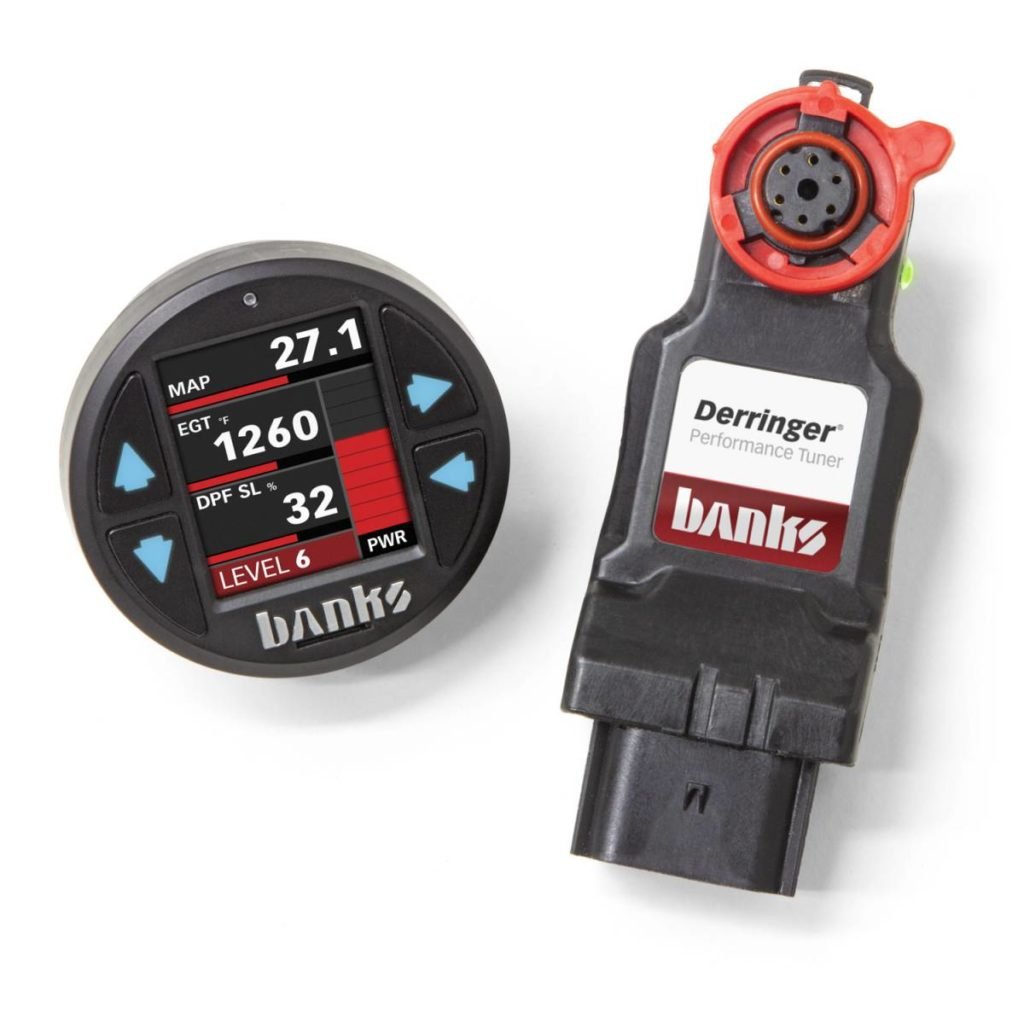
Just about every truck out there can benefit from a cold air intake, and by freeing up the intake tract and getting rid of sound resonators, airflow is improved, air density goes up, and horsepower is increased. Most intakes are C.A.R.B. legal, and if your dealer is a stickler, they can easily be swapped out for the stock parts in a couple minutes whenever you make a visit for warranty work. The perfect pairing for your L5P would be a Banks Ram Air Intake System, and it adds an additional 21 horsepower when used in conjunction with the Derringer Tuner.
Finally, it’s time to address the exhaust. You might not think there are any gains to be had, or any changes you can even make on an emissions intact truck, but believe it or not, there are ways to improve over stock. During a re-gen, the exhaust gas coming out of the DPF can be 900˚F or greater, and when manufacturers first started equipping trucks, it was reported the exhaust coming from the tail-pipe could melt nearby plastic, or if parked in tall grass, even start a fire. To reduce accidental fires and heat related damage, the diameter of the exhaust pipe is reduced down significantly to create a nozzle inside the exhaust about 12 to 18 inches from the end. Around the nozzle the pipe is slotted to allow ambient air in, and the nozzle creates a venturi effect which mixes the hot exhaust with outside air to cool things down before the gasses leave the tail pipe for good. While Smokey the Bear would thank you, the nozzle does restrict flow and performance. On an L5P Duramax the actual diameter of the hole is 2.85”, which is quite a bit smaller than the 4” exhaust it sits inside. If you want to add power, that restriction needs to go. Luckily, it is completely legal to modify the exhaust system AFTER the DPF, and the Banks 5” Monster Exhaust generates 85% less backpressure and 15% lower EGTs than stock, and when used in conjunction with the Derringer tuner and Ram-Air intake, the 5” tail pipe will add 18 horsepower, giving your L5P an additional 100 horsepower over stock while keeping all emissions systems intact and being C.A.R.B. legal. Not bad for an afternoon’s work, and it’s all at a very competitive price point, and warranty friendly.
No Warranty? No Problem!
While an in-line tuner is the perfect solution for those who don’t want to tamper with the stock computer, it does have limitations on how much power it can add, and that’s just a function of the sensors it interacts with on the engine, namely the Manifold and Fuel Rail Pressure sensors. An in-line tuner is unable to alter injection timing or duration, and that’s where you’ll get a lot more performance. Once you pass the magic 100,000-mile mark or simply don’t care about a factory powertrain warranty, you can now get into custom tuning of the ECM to add some serious power, but still keep emissions components 100% intact. In some cases like the 2015 and newer 6.7 Powerstroke, it’s possible to get over 550hp at the rear wheels while keeping all emissions components functioning with tuning from PPEI. For the 6.7, the best tool to load a custom tune into the computer is the EZ Lynk Auto Agent 2, which is a wireless cloud-based tuning device that allows a technician or calibrator to diagnose, datalog, or in our case, reflash the computer. The Auto Agent is simply the pass-through tool, and you can use your IOS or Android based smartphone or tablet to view your engines parameters in real time. How much power you gain and how well the truck runs all depends on the skill of the guy writing the calibrations, and Kory Willis from PPEI is a name you’ll hear over and over. For the 6.7 Powerstroke, the PPEI Custom Tuning adds an additional 150 horsepower over stock which can really wake up the Scorpion.
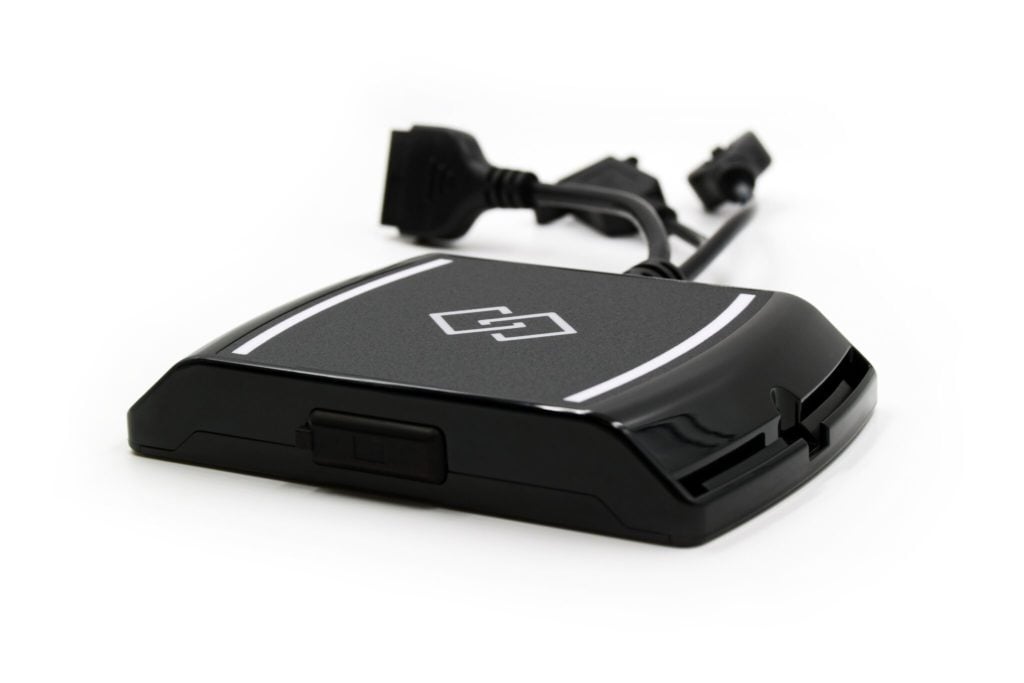
It’s worth noting, while the 2017+ L5P can be properly tuned, it’s an extensive (and expensive) process. For some reason, GM saw fit to equip the newest Duramax with CIA levels of encryption which prevents any aftermarket re-flash, and the codes are pretty much impossible to crack. However, HP Tuners has found a way to bypass the problem. They physically modify the circuitry inside the ECM and TCM, which allows a full re-flash with their MVPI-2 tool with tunes written by companies like Calibrated Power. With nothing more than a computer swap/tune, it’s now possible to get 550hp at the rear wheels from the new Duramax.
Beyond the Basics
While an additional 100 or 150 horsepower over stock sounds great, you may be tempted to find out just how far you can push a truck with all emissions components functioning, and whether you drive a Ford, Chevy, or Ram, if you want to get more than 550hp, you’ll need to start looking at the air delivery system. Every truck is optimized by the engineers to have a turbocharger that is responsive, produces lots of lower RPM torque, and keeps the EGT’s cool at the stock power level. Remember, these trucks were designed for towing a mountain, not winning the Indy 500, so the turbos are a bit on the smaller side. Whenever you want to exceed the design parameters of your engine, the turbo can be forced to operate outside of its ideal conditions, and this can cause excess backpressure in the exhaust and excessive heat coming out of the compressor side. This is normal when you operate a turbo outside its efficiency zone, and to solve those shortcomings, you need a larger turbo. Technically, the variable vanes in a VGT charger are part of the emissions system, so swapping to a fixed geometry S300 or 400 style of turbo won’t be “legal,” but a larger drop-in VGT charger like the Cheetah series from Fleece Performance is just what the doctor ordered. Not only do they retain the variable vanes, but they bolt right in place keeping your CARB legal intake and exhaust components functioning properly, and of course they will support more horsepower AND keep EGTs at an ideal range. Probably the coolest part about a slightly larger turbo is when combined with proper tuning, the frequency of regens will go down, saving you fuel.
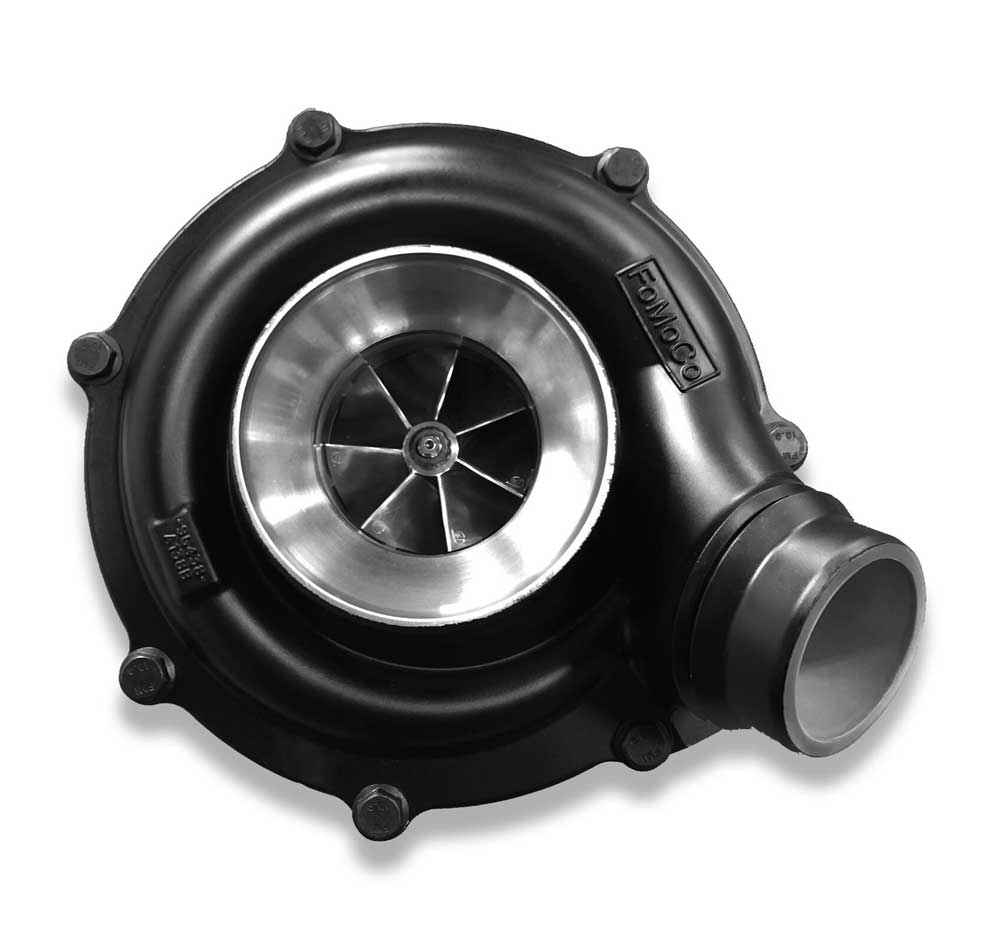
When you are making upgrades to the turbocharger, it makes sense to upgrade the exhaust manifold(s) at the same time, since they attach to the turbo. Just don’t forget to consider the EGR system still needs to work. For the Cummins crowd, BD Diesel’s 2-Piece exhaust manifold is constructed from a stronger than stock ductile iron which resists cracking from heat, but also flows much better than stock. Most importantly, it still has the two ports to attach the EGR cooler. On the Duramax, there is no EGR port on the exhaust manifold (L5P excluded) so you have free reign to upgrade those, but the up-pipe on the passenger side has an EGR riser which connects to the EGR Cooler which needs to be retained. Some of the best flowing manifolds for a Duramax are made by PPE, and they come with a matching up-pipe which has the appropriate EGR Riser to match your truck, whether you have an LLY, LBZ, LMM, or LML. Just like the BD manifold for the Cummins, new manifolds and up-pipes will provide more power, lower EGT, and perhaps best of all, quicker turbo spool-up.
An engine which operates at a lower combustion temperature (EGT) will run safer, longer, pollute less, and make more power, which is why you see us constantly emphasizing products which create more efficient airflow and reduce temperature. An intercooler is something you can change to help any emissions equipped diesel, and once again Banks Power has a great option with their Technicooler System. On top of the obvious benefits it gives for cooler air temperature, the intercooler tanks are much stronger than stock, which allows you to run higher boost pressure when you really want to go nuts. With a typical diesel build, the next step would be to add another turbo compounded on top of the stock charger, but normally this is impossible for an emissions friendly build, but as manufacturers get on board with clean power, new options are coming out every day. ATS Diesel has really stepped up in the Cummins world, and recently introduced the Aurora Vortex 5000 compound kit which works for late 4th gen Rams. Fitting the second turbo is made possible by the innovative cast elbow which connects the exhaust outlet of the stock turbo to the turbine inlet of the larger one, and also allows the exhaust from the larger turbo to connect directly to the stock down-pipe. Now, you can have 750 horsepower worth of air while keeping the response and drivability of a stock VGT and keep Uncle Sam and the NOX counters happy all at the same time.
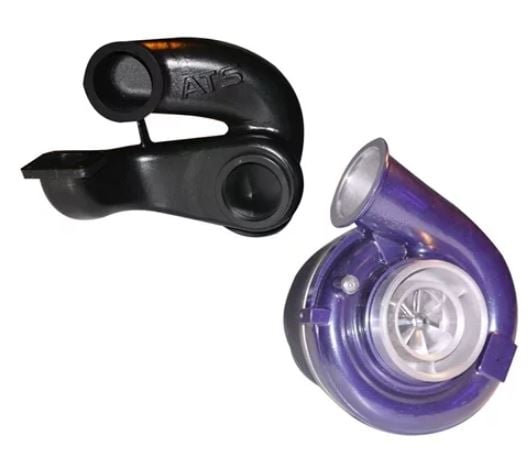
Other Ways To Go Fast
If you want to make a vehicle go faster, the first thought is to add more power to the engine. While I am a huge supporter of Tim “the tool-man” Taylor’s mindset, there are other ways to accomplish your goal, and that’s with leverage. Remember, inside the front and rear differential of your truck are a set of gears which multiply torque and dictate what RPM your engine is turning when you drive down the freeway. If you have lifted your truck and installed a taller set of tires, you probably noticed your acceleration got slower. A programmer can add a ton of torque and mask the symptom, (and cause more strain on your transmission) but you can gain a lot of acceleration back by re-gearing the differentials to match your tire size or intended application. Some trucks come stock with 3.31 or 3.42 gears which are great for fuel mileage and highway cruising, but not acceleration or taller tires. If you swap those out to a 3.73, 4.10, or even 4.30, you will be surprised how much quicker your truck gets without adding any horsepower to the engine. It will take a lot of parts and a skilled technician to install a ring and pinion gearset properly, but a Nitro Gear complete ring and pinion package comes with everything you need to change the gears, like new bearings, shims, seals, and hardware to make your install go nice and smooth.
Finally, if you want to go fast, remember the old hot-rodders rule of thumb: every 10 pounds removed is the same as adding one horsepower. So, think twice about adding that 300-pound winch and bumper combo, those giant 22” wheels and 40” tires, and maybe lose the bed full of tools and welder. Or, rather than starting a race truck build with a 9,000-pound crew cab dually, start with a single cab 2wd which might weigh closer to 6,000lbs: that 3,000-pound savings is like a 300hp gain.
Play Within The Rules
Whether or not you like it, emissions control devices are here to stay, and government agencies are strictly enforcing the rules, making sure manufacturers are in compliance. The good news is most modern ¾ or 1-ton diesels can still knock on the door of 20mpg while staying completely legal, and despite what we may think, most of us aren’t going to beat John Force with our pickups. To me, it just makes sense to keep your truck road legal, avoid the chance of getting a fix-it ticket, costly fine, or even voiding your warranty. And if you still think you can’t make big power with emissions intact, consider this: Wehrli Custom Fab and Calibrated Power teamed up and built an LML which made 733hp and 1,338 pounds of torque at the wheels with 100% of the emissions components still functioning, including the stock air box. No smoke, no smell, no straight pipe sound, and all the power. How’s that for having a cake and eating it too…

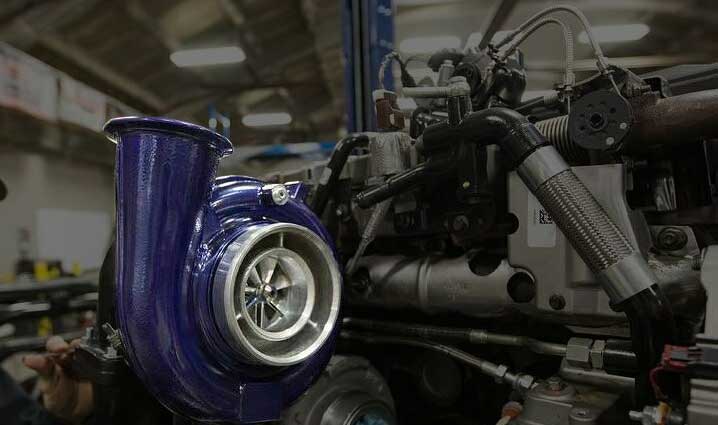
Are there modifications available for the 1.6 4cyl in the Cruze/Equinox/Terrain?
How may I get more power and fuel economy from this engine?
It looks like that as of right now, the options are still pretty limited for the 1.6L. Your best options for when products are released will be a cold air intake and even a DPF back exhaust system to start with. As of now, K&N does have one of their high flow drop-in replacement air filters which will help marginally. Beyond this, adding a good fuel additive, such as F-Bomb Diesel Additives (our preferred) will help by increasing the cetane index of the fuel you’re using in order to create a more efficient burn.
I’m really interested in this, as I want to get something like a LLY eventually. To be able to do a 600-700hp build but still keep everything emissions compliant. As all I hear to do it delete delete delete, but that’s getting regulated more and more strictly. Along with the fact that nobody is still thinking of emissions compliant tuning and thinking it’s all gone with diesel tuning because of the EPA deleting the delete and nobody knows what to do now. I’d love a emissions compliant LLY twin turbo duramax with all the clean power I can get from a diesel. Just don’t know if there is any kits currently or will be made for the LLY duramax which is the only duramax I could really afford in my price range between 8-13 grand for a used truck.
Nathan,
Thanks so much for the response. The good news is that the aftermarket manufacturers have quickly been getting on board with bringing to market emissions compliant products, and some have been on board since the beginning, really spearheading the entire operation as they essentially knew that the emissions defeat market would soon come to an end. There are numerous companies bringing CARB approved tuning products, and others with EPA approved tuning that, with the right combination of parts, deliver 600 horsepower. Overall, it just takes a different approach than others have taken in the past, but it is doable. Specifically for the LLY, some of the current limitations are going to be in the airflow department as manufacturers are still working on fully emissions compliant compound turbo kits for this generation of Duramax, as their focus recently has been on the newer trucks, but they’re telling us that they are definitely in the works. Thank you again for the great response and if you have any questions, feel free to reach out again!
Diesel Josh
I have a 2011 Ram 3500 4×4 Diesel since new, 576 523 km.
I am interested in keeping emission components intact, particulate filter, regen, egr.
I use this truck for work, 90 % highway driving, 5% for hauling a 35′ travel trailer, the rest on dirt roads
The truck came with
6.7L I6 Turbo Diesel Engine
6spd 68RFE Transmission.
5,500# Front Axle Conventional Differential
3 73 axle ratio , 11.50 rear axle, anti spin differential
The truck came with 17″R tires, I have changed those to 20″R.
Since there no warranty, what could you suggest for upgrades keeping the above mention components intact?
Most important to me would be fuel consumption than a little extra torque and hp in passing lanes and towing.
Also considering a 4″ lift!
Can you suggest what you think is best, or direct me to someone who can?
Ken Chaffer